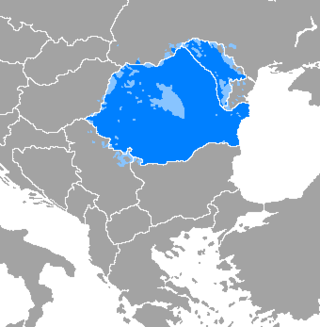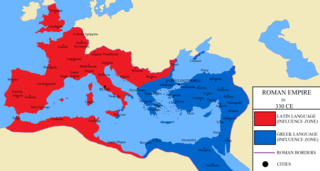Related Research Articles

The Italic languages form a branch of the Indo-European language family, whose earliest known members were spoken on the Italian Peninsula in the first millennium BC. The most important of the ancient Italic languages was Latin, the official language of ancient Rome, which conquered the other Italic peoples before the common era. The other Italic languages became extinct in the first centuries AD as their speakers were assimilated into the Roman Empire and shifted to some form of Latin. Between the third and eighth centuries AD, Vulgar Latin diversified into the Romance languages, which are the only Italic languages natively spoken today, while Literary Latin also survived.

Latin is a classical language belonging to the Italic branch of the Indo-European languages. Latin was originally spoken by the Latins in Latium, the lower Tiber area around Rome, Italy. Through the expansion of the Roman Republic it became the dominant language in the Italian Peninsula and subsequently throughout the Roman Empire. It has greatly influenced many languages, including English, having contributed many words to the English lexicon, particularly after the Christianization of the Anglo-Saxons and the Norman Conquest. Latin roots appear frequently in the technical vocabulary used by fields such as theology, the sciences, medicine, and law.

The Oaths of Strasbourg were a military pact made on 14 February 842 by Charles the Bald and Louis the German against their older brother Lothair I, the designated heir of Louis the Pious, the successor of Charlemagne. One year later the Treaty of Verdun would be signed, with major consequences for Western Europe's geopolitical landscape.

The Romance languages, also known as the Latin or Neo-Latin languages, are the languages that are directly descended from Vulgar Latin. They are the only extant subgroup of the Italic branch of the Indo-European language family.

Romanian is the official and main language of Romania and Moldova. Romanian is part of the Eastern Romance sub-branch of Romance languages, a linguistic group that evolved from several dialects of Vulgar Latin which separated from the Western Romance languages in the course of the period from the 5th to the 8th centuries. To distinguish it within the Eastern Romance languages, in comparative linguistics it is called Daco-Romanian as opposed to its closest relatives, Aromanian, Megleno-Romanian, and Istro-Romanian. It is also spoken as a minority language by stable communities in the countries surrounding Romania, and by the large Romanian diaspora. In total, it is spoken by 25 million people as a first language.

Vulgar Latin, also known as Popular or Colloquial Latin, is the range of non-formal registers of Latin spoken from the Late Roman Republic onward. Vulgar Latin as a term is both controversial and imprecise. Spoken Latin existed for a long time and in many places. Scholars have differed in opinion as to the extent of the differences, and whether Vulgar Latin was in some sense a different language. This was developed as a theory in the nineteenth century by Raynouard. At its extreme, the theory suggested that the written register formed an elite language distinct from common speech, but this is now rejected.
The Iberian Romance, Ibero-Romance or sometimes Iberian languages are a group of Romance languages that developed on the Iberian Peninsula, an area consisting primarily of Spain, Portugal, Gibraltar, Andorra and French Catalonia. They are today more commonly separated into West Iberian, East Iberian (Catalan/Valencian) and Mozarabic language groups. East Iberian's classification is a subject of ongoing scholarly debate, as some argue that the Occitano-Romance languages composed of Occitan along with the aforementioned two are better classified as Gallo-Romance languages.

The Gallo-Romance branch of the Romance languages includes in the narrowest sense the langues d'oïl and Franco-Provençal. However, other definitions are far broader and variously encompass the Occitan or Occitano-Romance, Gallo-Italic or Rhaeto-Romance languages.
Old French was the language spoken in most of the northern half of France approximately between the late 8th and the mid-14th century. Rather than a unified language, Old French was a group of Romance dialects, mutually intelligible yet diverse. These dialects came to be collectively known as the langues d'oïl, contrasting with the langues d'oc, the emerging Occitano-Romance languages of Occitania, now the south of France.

Old High German is the earliest stage of the German language, conventionally identified as the period from around 500/750 to 1050. Rather than representing a single supra-regional form of German, Old High German encompasses the numerous West Germanic dialects that had undergone the set of consonantal changes called the Second Sound Shift.

The langues d'oïl are a dialect continuum that include standard French and its closest autochthonous relatives historically spoken in the northern half of France, southern Belgium, and the Channel Islands. They belong to the larger category of Gallo-Romance languages, which also include the historical languages of east-central France and western Switzerland, southern France, portions of northern Italy, the Val d'Aran in Spain, and under certain acceptations those of Catalonia.
Middle French is a historical division of the French language that covers the period from the mid-14th to the early 17th centuries. It is a period of transition during which:

Frankish, also known as Old Franconian or Old Frankish, was the West Germanic language spoken by the Franks from the 5th to 9th century.
French is a Romance language that specifically is classified under the Gallo-Romance languages.

Elbe Germanic, also called Irminonic or Erminonic, is a term introduced by the German linguist Friedrich Maurer (1898–1984) in his book, Nordgermanen und Alemanen, to describe the unattested proto-language, or dialectal grouping, ancestral to the later Lombardic, Alemannic, Bavarian and Thuringian dialects. During late antiquity and the Middle Ages, its supposed descendants had a profound influence on the neighboring West Central German dialects and, later, in the form of Standard German, on the German language as a whole.

The Catalan language originated from Vulgar Latin in the Pyrenees Mountains between France and Spain. It diverged from the other Romance languages in the 9th century. At that time, Catalan spread quickly throughout the Iberian peninsula when the Catalan counts conquered Muslim territory. By the 11th century, the Catalan language was present in several feudal documents. Catalan was present throughout the Mediterranean by the 15th century. At that time, the city of Valencia was thriving.
In linguistics, a conservative form, variety, or feature of a language is one that has changed relatively little across the language's history, or which is relatively resistant to change. It is the opposite of innovative, innovating, or advanced forms, varieties, or features, which have undergone relatively larger or more recent changes. Furthermore, an archaic form is not only chronologically old but also rarely used anymore in the modern language, and an obsolete form has fallen out of use altogether. An archaic language stage is chronologically old, compared to a more recent language stage, while the terms conservative and innovative typically compare contemporary forms, varieties or features.
The re-latinization of Romanian was the reinforcement of the Romance features of the Romanian language that happened in the 18th and 19th centuries. Romanian adopted a Latin-based alphabet to replace the Cyrillic script and borrowed many words from French as well as from Latin and Italian, in order to acquire the lexical tools necessary for modernization. This deliberate process coined words for recently introduced objects or concepts (neologisms), added Latinate synonyms for some Slavic and other loanwords, and strengthened some Romance syntactic features. Some linguistic researchers emphasize that the use of this term is inappropriate as it conflates the larger process of modernization of the language with the more extreme, and in the end unsuccessful, current of eliminating non-Latin influences, and, secondly, the term's lack of precision is susceptible to lead to confusion as the Latin character of the Romanian language had already been noticed since at least the 15th century.
Old Gallo-Italic, also referred as Old Lombard, or Old Northern Italian is a Gallo-Romance language spoken from 900 until 1500. The language is similar to Old Occitan, which was spoken around the same area. Most texts were written in the Lombard koiné.
References
- ↑ "Gallo-Romance". The Free Dictionary. Retrieved 2024-06-24.
- ↑ Watson, Nicholas (2022-06-21). Balaam's Ass: Vernacular Theology Before the English Reformation: Volume 1: Frameworks, Arguments, English to 1250. University of Pennsylvania Press. p. 30. ISBN 978-0-8122-9834-5.
- ↑ Loporcaro, Michele (2018). Gender from Latin to Romance: History, Geography, Typology. Oxford University Press. pp. 206–207. ISBN 978-0-19-965654-7.
- ↑ Dufter, Andreas; Stark, Elisabeth (2017-09-25). Manual of Romance Morphosyntax and Syntax. Walter de Gruyter GmbH & Co KG. p. 101. ISBN 978-3-11-037708-8.
- ↑ Lema, José; Treviño, Esthela (1998-01-01). Theoretical Analyses on Romance Languages: Selected Papers from the 26th Linguistic Symposium on Romance Languages (LSRL XXVI), Mexico City, 28-30 March, 1996. John Benjamins Publishing. p. 108. ISBN 978-90-272-3662-3.
- ↑ Jr, Robert A. Hall (1984-01-01). Proto-Romance Morphology: Comparative Romance Grammar. John Benjamins Publishing. ISBN 978-90-272-8014-5.
- ↑ Ledgeway, Adam; Roberts, Ian (2017-03-09). The Cambridge Handbook of Historical Syntax. Cambridge University Press. p. 64. ISBN 978-1-316-72058-5.
- ↑ « Moyen Âge : l'affirmation des langues vulgaires » in the Encyclopædia universalis.
- ↑ Bernard Cerquiglini, La naissance du français, Paris, Presses universitaires de France, 1991, Que-sais-je ? ; éd. mise à jour, 2007.
- ↑ Conference of Claude Hagège at the historical museum of Strasbourg, p. 5, (read online) Archived 2015-04-08 at the Wayback Machine